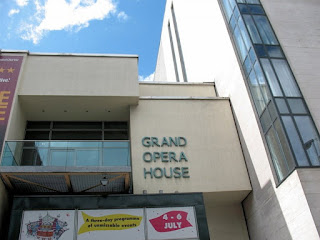 We saw our first rays of true sunhine in Belfast, North Ireland. Cautiously optimistic, we dressed in layers as a precaution - it was like a Fall day in the Midwest but overall, we were quite comfortable.
We saw our first rays of true sunhine in Belfast, North Ireland. Cautiously optimistic, we dressed in layers as a precaution - it was like a Fall day in the Midwest but overall, we were quite comfortable.
Our main objective of the day was to visit the Titanic Museum, and we off the ship and in line for tickets by 10am. As most of you know I’m sure, the Titanic was constructed and launched in Belfast – the museum, a 6-story building of modern design was constructed over the production and assembly facility, which once employed thousands of workers. The museum itself is nicely done with multiple story boards and videos – there’s even a Disney-type ‘ride’ that transports you through various elements of the ship construction process but overall, we were disappointed. We were expecting to see actual Titanic artifacts and there are none in the facility – absolutely none. They’ve recreated some of the staterooms, furniture & china, but nothing authentic. Well-done, but Titanic artifacts, wherever they may currently reside, definitely belong in Belfast where it all began.
Belfast itself, is the capital and largest city of Northern Ireland, and the second largest on the island of Ireland. On the River Lagan, it has a population today of roughly 350,000, though it looks and feels much larger. We had an excellent tour guide and learned a lot about the city and her history. Belfast was the center of the Irish linen, tobacco-processing, rope-making and shipbuilding industries: in the early 20th century, Harland and Wolff, who built the Titanic, was the world's biggest and most productive shipyard. Belfast also played a key role in the Industrial Revolution, and was a global industrial center until the latter half of the 20th century. It has sustained a major aerospace and missiles industry since the mid-1930s. Industrialization and the inward migration it brought made Belfast Ireland's biggest city at the beginning of the 20th century.
Today, Belfast remains a center for industry, as well as the arts, higher education, business, and law, and is the economic engine of Northern Ireland. We actually enjoyed visiting Belfast more than Glasgow. The city suffered greatly during what they refer to as… “The Troubles” … but in recent years, has undergone a sustained period of calm, free from the intense political violence of former years, and substantial economic and commercial growth. Additionally, Belfast city center has undergone considerable expansion and regeneration in recent years, notably around Victoria Square & City Hall – several active construction sites today. In many cases and to our surprise, when renovating an ‘old’ building, they leave and preserve as much of the timeworn front architecture as possible, and build the new behind it!
I mentioned “theTroubles” earlier, and our guide went into some pretty heavy detail as we toured the city and viewed some of the hot spots - the scene of various episodes of sectarian conflict between its Catholic and Protestant populations. These opposing groups in this conflict are now often termed republican and loyalist respectively, although they are also loosely referred to as 'nationalist' and 'unionist'. The most recent example…a civil conflict that raged from around 1969 to 1998. Some of the worst occurred in the 1970s, with rival paramilitary groups formed on both sides…and then bombing, assassinations and street violence formed a backdrop to life throughout the entire city. The Provisional IRA detonated 22 bombs within the confines of city center in 1972, on what is known as "Bloody Friday", killing eleven people. We were able to walk the entire area. Loyalist paramilitaries including the Ulster Volunteer Force (UVF) and the Ulster Defense Association (UDA) claimed that the killings they carried out were in retaliation for the IRA campaign. Most of their victims were Catholics with no links to the Provisional IRA. A particularly notorious group, based on the Shankill Road in the mid-1970s, became known as the Shankill Butchers.
In all, over 1,600 people were killed in political violence in the city between 1969 and 2001. Sporadic violent events continue as of today, although not supported by the previous antagonists who had reached political agreement in 1998. With that said, there are still gates throughout the city that close automatically each night at 6pm for 12 hours, separating the Catholic from Protestant neighborhoods.
We never once felt threatened in any way, though there were a few bizarre-looking individuals dressing up the street corners – they probably thought the same about us. My only uneasy encounter was in a Burger King restroom. A middle-aged man asked for $1 to buy food and honestly, I would’ve given it to him but had no cash on me. Then he asked me if I wanted some “tablets”. Thankfully, other customers started to enter the restroom about that time so our conversation came to a quick stop and I was able to get out of there. We never saw him again. Overall, folks were very friendly & accommodating. The city is basically clean, with the exception of a few areas you’d classify as urban decay – something you find in most all major cities. Public transportation is abundant, very accessible, and reasonably priced.
On our way now to Killybegs, Ireland, located on the western or Atlantic side of the island. We’re hearing about yet another storm system which may impact our itinerary, but won’t know anything definite for another day or two.




















































































































































No comments:
Post a Comment